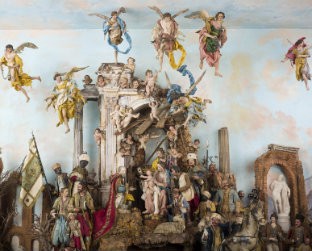Angels overhead

Recently I went to see the newly acquired 18th-century Neopolitan crèche at Chicago’s Art Institute. The giant crèche fills a 15’X15’ cabinet. It will be exhibited for only five weeks because the dozens of terra cotta figurines, each about five to eight inches tall, are dressed in handmade embroidered fabrics too fragile to be exposed to the air year-round. (Hopefully the crèche will be back next Christmas).
Directly in front of me was a crowded Neopolitan neighborhood scene. I tried to take in some of the dozens of scenes in a busy marketplace frozen in time. There’s a woman carrying a basket of fruit that is itself a carefully created miniature still life. Animals (there are 50 of them) race under tables (dogs), munch on grass (sheep) or peck at the feet of a woman who is shaking feed from her apron (chickens). On the porch of a taverna some men play musical instruments while another sits waiting with a deck of cards. Meat carcasses hang in the open air; women chat animatedly around a fire. There are caned chairs, ceramic bowls, candlesticks and tambourines; there are lovers and pickpockets. In one corner a shepherd sleeps through it all. It’s like reading a Dickens novel.
Then I looked up past the cacophony of humans to a ledge above. There sits the newborn babe and family. It seems completely detached from the scene below—apparently no one below has yet seen the Holy Family except for a couple of shepherds and a swarm of miniature cherubs.
Tilting my head to look up even higher, I discovered a third layer of activity. Above the Holy Family and miles above the human scene, exquisite angels hover in the air. One has her foot extended gracefully; another waves an arm wrapped with a satin ribbon. The angels don’t seem to mind haggling market sellers or a robbery-in-progress on earth. They hear only the music of celebration for the arrival of a newborn holy king.
I came back to the museum later for an improvised interpretation of the crèche by the Hubbard Street Dance Company. How would the dancers convey the drama of the human community, I thought? How to represent angels and, most importantly, the incarnational moment?
At first I was fascinated. Dancers emerged one by one from the audience and ran up and down the stairs, or embraced each other, or stretched out like cats against the auditorium walls. One young woman stayed at the center back of the stage throughout the performance, moving in slow motion, sometimes sitting, sometimes lying down. (Later someone said that this was the newborn baby.)
Yes, it was a pleasure to watch the dexterity and grace of the dancers. And yes, I did identify some 18th-century crèche people in the dancers who slept through the presentation on the stage (shepherds), those who chased each other through the aisles in mad delight (Neopolitan lovers) and those who raced up and down the auditorium steps on all fours (sheep? dog?). But overall I was disappointed. I didn’t experience even a flicker of inspiration or celebration in their nativity message.
Later in the week, however, I had a different impression of the dance experience. I started thinking about the spectators. There were those who watched the entire dance through their smartphones and tablets. There were those of us who awkwardly turned in our seats and turned back again, trying to see the dancers who were all around us. One spectator jumped in surprise when a dancer popped up behind him; another reluctantly pet the sweaty “dog actor” who was running up the stairs. This small, impromptu crowd represented many different lives, many places of personal chaos, and a 21st-century cacophony of gadgets and schedules and upscale shopping trips. Maybe not so unlike the 18th-century Neopolitan folks. We were another crowd of yearning humans.
If I may push the parallel one step further, we were like the crèche folks too in that although we noted the actors playing dogs, lovers and a sleeping shepherd, we might still be missing the breakthrough event happening, say, just above our heads, or next to us, or behind, in the person in need who has found a helper or the family in crisis that has found a listener. We really ought to look up and around a little more often. Perhaps we’ll see angels dancing above us and tuning up to sing a song of great joy.



